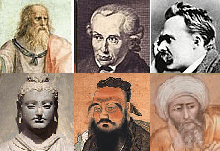Philomath
| Part of a series on |
| Philosophy |
|---|
 |
| Philosophers |
| Traditions |
| Periods |
| Literature |
|
| Branches |
| Lists |
| Miscellaneous |
|
|
A philomath (/ˈfɪləmæθ/;[1] Greek: φίλος philos ("beloved," "loving," as in philosophy or philanthropy) + Greek μανθάνειν manthanein, math- ("to learn," as in polymath)) is a lover of learning and studying. Philomathes, a Lover of Learning as compared to Philalethes, a Lover of Truth.[2] Philomathy is similar to, but distinguished from, philosophy in that -soph, the latter suffix, specifies "wisdom" or "knowledge", rather than the process of acquisition thereof.
Philomath is not synonymous with polymath. A philomath is a seeker of knowledge and facts, while a polymath is a lover desiring learning in multiple fields in the pursuit of knowledge.
The shift in meaning for mathema is likely a result of the rapid categorization during the time of Plato and Aristotle of their "mathemata" in terms of education: arithmetic, geometry, astronomy, and music (the quadrivium), which the Greeks found to create a "natural grouping" of mathematical (in the modern usage; "doctrina mathematica" in the ancient usage) precepts.
In a philosophical dialogue, King James first penned the character Philomathes to debate on arguments of whether the ancient religious concepts of witchcraft should be punished in a politically fueled Christian society. The arguments King James poses through the character Epistemon are based on concepts of theological reasoning regarding society's belief as his opponent, Philomathes, takes a philosophical stance on society's legal aspects but sought to obtain the knowledge of Epistemon. This philosophical approach signified a philomath seeking to obtain greater knowledge through epistemology. The dialogue was used by King James to educate society on various concepts including the history and etymology of the subjects debated.
See also
- Benjamin Franklin, who used this pen name.
- King James, who used a character named Philomathes to debate on the topics of witchcraft in his dissertation of Daemonologie.
- Philomaths, Polish secret student organization that existed, 1817–23, at the Imperial University of Vilnius.
- Philomathean Literary Society (Erskine College)
- Philomathean Society, a literary society at the University of Pennsylvania.
- Philomathean Society (New York University)
References
- ↑ "Philomath". Oxford Dictionaries. Oxford University Press. Retrieved 2016-01-22.
- ↑ Thomson, George, MD. (1675). Ortho-methodoz itro-chymikē: or the direct method of curing chymically.